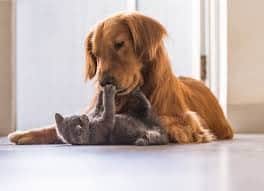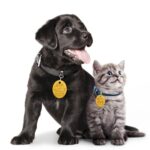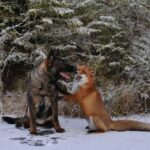
Introducing a new animals to one another can be a little tricky. You want your current pets and your new pet to live harmoniously with each other. Remember, be realistic about your expectations. Some dogs just do not get along with other dogs. Other dogs have high prey drives, so their reaction to smaller animals is that of a hunter chasing down prey. This instinct may override their ability to stay calm around smaller pets.
To help ensure good first interactions and blend the new family together is to separate everyone initially, let everyone get used to the new smells in the house, then closely supervise any interactions among the pets for a while, slowly increasing the amount of time your pets spend together.
In order to avoid any inappropriate behaviors from your new pet or your current ones (e.g., urinating outside the litterbox, chasing, hiding), everyone should be comfortable together, not just tolerating each other. And if there are cats in the house, adding litterboxes and extra food and water dishes can help as they get adjusted.
Your new dog should be examined by a veterinarian to ensure he/she is healthy and free of contagious diseases. Discuss your concerns about the upcoming introductions with your vet so you can get as many tips and suggestions as possible to make adding a new pet a smooth transition.
Introductions to Other Dogs
When introducing a new dog to your current dog(s), the point is to avoid reaching the threshold where they start to growl and posture, not separate them afterwards. Basically, you want to start with only positive interactions.
Start by keeping the new one separated from the current resident(s) and let him/her sniff out the house alone. It is a good idea to start supervised visual contact without having them interact at first (i.e., keep the new dog leashed and across the room from the current and leashed dog(s) so they can see each other). Then while they are both leashed, supervise them together. You can also let them meet outside in the yard in more neutral territory.
If any growling or lunging aggressively occurs, you may need to re-separate them and back up a few steps for a while. If the dogs get along well but start to play too roughly with each other, take a break from playtime.
If the aggression continues, separate them again, and follow this with supervised interactions until they are able to interact without getting too worked up.
Make sure each dog has their own food, toys, and water to help prevent fighting over these objects. Give each dog plenty of your attention and affection, even if that means separating them to do so. It is also a good idea to feed the dogs separately until they get used to each other, and then supervise their meals very closely.
Understand that there is a honeymoon period when a new dog comes into the home, during which the new dog slowly becomes more comfortable and behaviors that were not evident at first can emerge.
Over time, creating a daily routine that involves time together, time apart, and exercise will go a long way towards keeping all pets comfortable and happy. Exercising them together by walking them on separate leashes, possibly with one person to each dog, is a great way to help them get used to each other in an enjoyable manner. Always remember to reward good behavior.
Puppy Introductions

Introducing a new puppy to your pet family is different than introducing an adult dog. Puppies generally have a harder time interacting properly in social settings because they haven’t learned how. But the flip side is, most don’t have bad habits and won’t be territorial.
Puppies learn how to behave by being taught by other dogs, such as their mother and siblings. So when you bring an energetic, rough-playing puppy home to meet your other pets, you will likely notice that the other pets seem almost annoyed by these interactions. An older dog may nip or growl at the new puppy when the puppy crawls on him and tugs on his ears. This is technically normal, but needs to be carefully monitored so it doesn’t escalate from appropriate corrections to something more aggressive and serious.
Introducing the puppy to a cat is similar: the persistence of a puppy can lead to what appears to be rude behavior by the cat (swatting at the puppy or hissing). An older cat may be very nervous around a big bounding puppy. It can be normal for the cat to swat or hiss to let the puppy know to “cool it”.
Don’t yell or reprimand your adult animal for correcting the puppy. Simply remove them from the current interaction. Remember to keep everyone distracted with their own treats/toys during their time together.
Your current dog may feel uncomfortable around a puppy who does not really understand the adult dog’s communication, and so the puppy doesn’t realize the dog doesn’t want to interact.
An older dog may signal disinterest by getting up and moving away. If the adult does that and the puppy follows the adult around anyway, the puppy is not understanding the adult’s communication. If the puppy jumps on the adult, the puppy is really not understanding his communication; The adult dog may then snap at the puppy or raise his lip, which is a higher level of communication. The adult dog has raised his “go away and leave me alone” to “go away and leave me alone, or else…” This is appropriate communication and should not be punished. If the puppy doesn’t understand the adult’s communication to go away, you should intervene and remove the puppy from the situation and praise your adult dog for using appropriate communication and not harming the puppy.
When the adult dog is communing peacefully around the puppy, you should praising the adult dog and let the adult dog know that good things can happen with he or she is with the puppy. You can praise him for interest in the puppy by calling the puppy away and throwing a treat to the adult.
Remember to give a treat to the puppy for coming to you when you call. Also, the puppy can start shortening interactions with the adult and come to you for stimulation. If you do not want to do something with the puppy, you can redirect him to toys that he can play with by himself.
Everyone needs personal space. Be sure to limit the puppy’s time with your other pets so they get a good break. Having a new baby of any kind in the household can be tough on an older pet because of the energy required in spending time with and helping to raise a puppy. Make sure to give your current pets plenty of time alone with you so they don’t feel left out.
It’s helpful to take your puppy to obedience training so he can interact with other unknown dogs and learn appropriate behaviors.
Introductions to Cats
For new dogs that are calm or laid back, place them in a kennel or crate and allow your cat to check out the outside of the crate for as long as he wants. The dog should not be growl or try to get to the cat. For a dog that is more excitable, has separation anxiety, or has a history of aggression towards cats, place him on a leash next to you in the house and let the cat come over at his leisure. Consider feeding the cat at a safe distance during this time so your cat will recognize that he can eat around the dog without being chased. This is where extra litterboxes, food and water dishes come in handy. You want your cat to be comfortable.

Once your new dog is settled in, be sure to allow your cat to regularly explore the house alone for all of the new smells your dog will bring with him. This may involve putting the dog in a kennel or a separate room for a little while.
Equally important, provide your cat with a dog-free space that he/she can go to as needed whenever they want. Even once your dog and cat show that they can interact positively, continue to keep your new dog on a leash and supervise interactions for a while.
The leash will help you prevent unexpected chasing or signs of aggression from the dog. During these interactions, your new dog can be kept busy and distracted with his own food, treats, chew toys, and loving attention from you. Keep yourself calm as well. Do not yell at, hit, or punish your dog or cat if things don’t go well on the first try. Reward everybody for being calm and polite to their new roommate. It is important during these interactions that your cat has a place to escape if he feels scared or threatened. Hiding under furniture, a tall cat tree/perch, or ideally, a baby gate that he can jump over or crawl under to get to another room are all great options and should be available for your cat for a long time, even after your dog has proven he is no threat to your cat.
If your new dog has a history of aggression towards cats, or if he shows aggression towards your cat during his interactions, you may want to consider a basket muzzle during their supervised interactions and avoid time alone with each other. As stated above, some dogs have such an intense prey drive that they can’t overcome those instincts no matter how hard they try.
Tomorrow’s article will focus on introducing to prey animals – rodents, rabbits and more.


